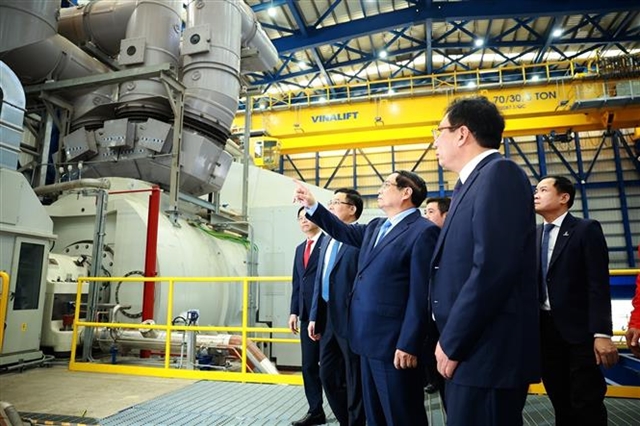 Economy
Economy

 |
| Workers at a factory in the northern province of Bắc Ninh. — VNA/VNS Photo |
HÀ NỘI — As many as 10 out of a total of 15 socio-economic development targets for 2023 are on track, according to a recent report released by the Ministry of Planning and Investment (MPI).
Given the current global economic downturn and difficulties, it's still unclear whether all targets can be met by the end of the year, said the ministry.
Some targets such as GDP growth, GDP per capita, the share of manufacturing and processing industries in GDP, labour productivity growth rate, and the proportion of agricultural labour in the total labour force will need more time to catch up. If said targets, which are among some of the most important indicators of Việt Nam's economy, cannot be met by the end of 2023, measures shall be taken to achieve the highest possible improvement instead.
However, meeting all of the targets will likely be challenging. For example, achieving the GDP growth target of 6.5 per cent this year. While the economy has been steadily recovering, especially during the last quarter, some obstacles cannot be overcome within a short period of time, according to Nguyễn Chí Dũng, minister of planning and investment.
According to the report, macro-economic indicators for the first eight months indicate that the economy has been still facing significant challenges. Exports and imports have continued on a declining trend by 10 per cent and 16.2 per cent respectively, compared to the same period last year; the country's Industrial Production Index (IIP) was still down by 0.4 per cent.
Meanwhile, credit growth remains sluggish, the number of businesses temporarily ceasing operations is increasing, and the growth of business investments is slowing down, with fewer large-scale industrial processing and manufacturing projects, which will likely hinder not just short-term growth but also the capacity for long-term economic development.
"Our GDP growth in the first half of 2023 was only 3.72 per cent, lower than the set target. This has created significant pressure on the last six months of the year, during which we must maintain a 7-8 per cent GDP growth rate," said deputy minister of planning and investment Trần Quốc Phương.
Slower growth for the economy has been forecast. For instance, in the updated macro-economic report for August 2023, the World Bank predicts that the Southeast Asian economy's growth could reach just 4.7 per cent for the year, significantly lower than the previous forecast of 6.3 per cent.
The country's top priority for the remainder of the year from this point on is to make all possible efforts to achieve the highest possible level of growth. In a recent government meeting, Prime Minister Phạm Minh Chính issued a directive to all governmental agencies to seek and implement solutions to boost growth while ensuring macro-economic stability, controlling inflation, and addressing major imbalances in the economy.
There have been signs that the economy is in a prime position to make a strong comeback. The country's Purchasing Managers' Index (PMI) for August 2023, according to a recent announcement by S&P Global, has risen to 50.5 points after continuously staying below the 50-point threshold for six months, indicating both production and new order quantities are increasing.
"The new PMI for Việt Nam's manufacturing sector paints a brighter picture of its health compared to recent months, with increased production, new order quantities, export activities, and purchasing activities," said Andrew Harker, Director of Economics at S&P Global Market Intelligence.
He, however, remained cautiously optimistic as the overall improvement was still weak while demand remains fragile.
"It is still too early to say that the manufacturing sector has fully recovered," he said.
Economist Phạm Thế Anh from the National Economics University said that while the economy has somewhat recovered from the worst position since the COVID-19 pandemic, growth has not returned to pre-pandemic level and may remain sluggish in the short to mid-term.
Anh said some of the hardest hit were the industrial sector, especially manufacturing and processing for export, and related industries tied to real estate in the domestic market. To make matters worse, some of the world's largest economies look to maintain high interest rates at least until the end of the year.
Given the current situation, policies to support businesses and stimulate demand must be implemented, he said.
A healthy budget and relatively low public debt are among a few of the silver linings, allowing fiscal policies and government spending stimulus measures, including public investment, to be the important growth drivers for the economy.
Deputy Phương said a viable option for the remainder of the year is to focus on three major growth drivers: the service sector, the agriculture sector and the domestic market.
Earlier, in a report by the BIDV Training and Research Institute, the economy was forecast to grow by 4.4-4.5 per cent in the most pessimistic scenario and by 5.5-6 per cent in the most optimistic one. — VNS




